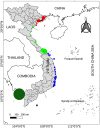Current advances in seagrass research: A review from Viet Nam
- PMID: 36299785
- PMCID: PMC9589349
- DOI: 10.3389/fpls.2022.991865
Current advances in seagrass research: A review from Viet Nam
Abstract
Seagrass meadows provide valuable ecosystem services but are fragile and threatened ecosystems all over the world. This review highlights the current advances in seagrass research from Viet Nam. One goal is to support decision makers in developing science-based conservation strategies. In recent years, several techniques were applied to estimate the size of seagrass meadows. Independent from the method used, there is an alarming decline in the seagrass area in almost all parts of Viet Nam. Since 1990, a decline of 46.5% or 13,549 ha was found. Only in a few protected and difficult-to-reach areas was an increase observed. Conditions at those sites could be investigated in more detail to make suggestions for conservation and recovery of seagrass meadows. Due to their lifestyle and morphology, seagrasses take up compounds from their environment easily. Phytoremediation processes of Thalassia hemprichii and Enhalus acoroides are described exemplarily. High accumulation of heavy metals dependent on their concentration in the environment in different organs can be observed. On the one hand, seagrasses play a role in phytoremediation processes in polluted areas; on the other hand, they might suffer at high concentrations, and pollution will contribute to their overall decline. Compared with the neighboring countries, the total C org stock from seagrass beds in Viet Nam was much lower than in the Philippines and Indonesia but higher than that of Malaysia and Myanmar. Due to an exceptionally long latitudinal coastline of 3,260 km covering cool to warm water environments, the seagrass species composition in Viet Nam shows a high diversity and a high plasticity within species boundaries. This leads to challenges in taxonomic issues, especially with the Halophila genus, which can be better deduced from genetic diversity/population structures of members of Hydrocharitaceae. Finally, the current seagrass conservation and management efforts in Viet Nam are presented and discussed. Only decisions based on the interdisciplinary cooperation of scientists from all disciplines mentioned will finally lead to conserve this valuable ecosystem for mankind and biodiversity.
Keywords: degradation; distribution; diversity; ecosystem services; seagrass; taxonomy.
Copyright © 2022 Nguyen, Phan, Cao, Nguyen Nhat, Nguyen, Nguyen, Lau, Hoang, Nguyen-Thi, Nguyen, Dao, Teichberg and Papenbrock.
Conflict of interest statement
The authors declare that the research was conducted in the absence of any commercial or financial relationships that could be construed as a potential conflict of interest.
Figures





Similar articles
-
The distribution characteristics of β-propeller phytase genes in rhizosphere sediment provide insight into species specialty from phytic mineralization in subtropical and tropical seagrass ecosystems.Ecotoxicology. 2021 Nov;30(9):1781-1788. doi: 10.1007/s10646-021-02425-2. Epub 2021 Jun 11. Ecotoxicology. 2021. PMID: 34115256
-
Coastal and estuarine blue carbon stocks in the greater Southeast Asia region: Seagrasses and mangroves per nation and sum of total.Mar Pollut Bull. 2020 Nov;160:111168. doi: 10.1016/j.marpolbul.2020.111168. Epub 2020 Oct 10. Mar Pollut Bull. 2020. PMID: 33181914 Review.
-
Seagrass decline weakens sediment organic carbon stability.Sci Total Environ. 2024 Aug 10;937:173523. doi: 10.1016/j.scitotenv.2024.173523. Epub 2024 May 25. Sci Total Environ. 2024. PMID: 38797423
-
What drives putative bacterial pathogens removal within seagrass meadows?Mar Pollut Bull. 2021 May;166:112229. doi: 10.1016/j.marpolbul.2021.112229. Epub 2021 Mar 9. Mar Pollut Bull. 2021. PMID: 33711607
-
Trends in seagrass research in the 21st century - are we there yet?Mar Environ Res. 2025 Aug;209:107198. doi: 10.1016/j.marenvres.2025.107198. Epub 2025 Apr 29. Mar Environ Res. 2025. PMID: 40334330 Review.
Cited by
-
Tests for segregation distortion in tetraploid F1 populations.Theor Appl Genet. 2025 Jan 16;138(1):30. doi: 10.1007/s00122-025-04816-z. Theor Appl Genet. 2025. PMID: 39814998 Free PMC article.
-
Taxonomic and functional β-diversity patterns reveal stochastic assembly rules in microbial communities of seagrass beds.Front Plant Sci. 2024 Feb 28;15:1367773. doi: 10.3389/fpls.2024.1367773. eCollection 2024. Front Plant Sci. 2024. PMID: 38481397 Free PMC article.
-
Halophila stipulacea: A Comprehensive Review of Its Phytochemical Composition and Pharmacological Activities.Biomolecules. 2024 Aug 12;14(8):991. doi: 10.3390/biom14080991. Biomolecules. 2024. PMID: 39199379 Free PMC article. Review.
References
-
- Ahmad J., Ali A. A., Baig M. A., Iqbal M., Haq I., Irfan Qureshi M. (2019). “Chapter 8 - role of phytochelatins in cadmium stress tolerance in plants,” in Cadmium toxicity and tolerance in plants. Eds. Hasanuzzaman M., Prasad M. N. V., Fujita M. (Elsevier Inc.: Academic Press; ), 185–212.
-
- Arriesgado D. M., Kurokochi H., Nakajima Y., Matsuki Y., Uy W. H., Fortes M. D., et al. . (2015). Genetic diversity and structure of the tropical seagrass Cymodocea serrulata spanning its central diversity hotspot and range edge. Aquat. Ecol. 49, 357–372. doi: 10.1016/B978-0-12-814864-8.00008-5 - DOI
-
- Barnes R. S. K. (2022). Biodiversity differentials between seagrass and adjacent bare sediment change along an estuarine gradient. Estuar. Coast. Shelf Sci. 274, 107951. doi: 10.1016/j.ecss.2022.107951 - DOI
-
- Boquete M. T., Lang I., Weidinger M., Richards C. L., Alonso C. (2021). Patterns and mechanisms of heavy metal accumulation and tolerance in two terrestrial moss species with contrasting habitat specialization. Environ. Exp. Bot. 182, 104336. doi: 10.1016/j.envexpbot.2020.104336 - DOI
-
- Bujang J. S., Zakaria M. H., Short F. T. (2016) (Netherlands, Dordrecht), 1–9.
Publication types
LinkOut - more resources
Full Text Sources

